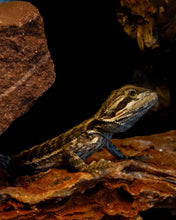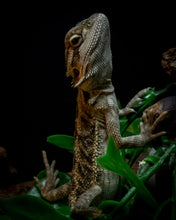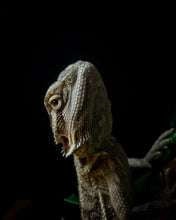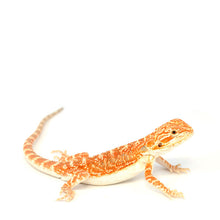Species: Bearded Dragon, Pagona vitticeps
Country: Australia, all captive Dragons found out of Australia are bred from Central Australian Bearded Dragons
Biome: Terrestrial, Arid
Activity: Diurnal
Maximum Size: 20-24 inches
Lifespan: 4-12 years
Food: Omnivores- as juveniles they eat more insects and should be fed as much as they can eat in one sitting, whilst veg should always be on offer. Rule of thumb is 80% insects and 20% Veg, which swaps as adults. As adults they should only be fed insects every third day at most, with veg always on offer.
They should be fed a wide variety of insects such as crickets, locusts and dubia roaches. They size of these will increase with age, but a rough guide is the insect should only be smaller than the gap between the animal’s eyes. Grub food, such as waxworms and mealworms, should be fed sparingly and as treats as these can be quite fatty. Good Veg items include dark leafy greens such as kale, cabbage and lettuces – but not Iceberg lettuce! During springtime a wide variety of wildflowers and weeds can be fed, such as dandelion leaves and flowers.
All food should have a light dusting of calcium powder, with one day off. Once a month a multivitamin should also be provided. Gut loading feeders is also important, feed them all the veg you would your animal!
Basking Temperature: 40◦C, this should be read directly under the basking light. The surface temperature will be much warmer than this, which is quite normal. The lizard will move on and off as he needs.
Temperature Range: 18-40◦C. The vivarium should have a hot side and a cool side. The hot side, in the day, will usually read 35◦C with the basking spot reading much higher. The cool side, in the day, will usually read around 28◦C. At night, the basking light should be switched off and a drop in temperature achieved.
Humidity Range: 20-60% A water bowl should be provided on the cool end of the vivarium which can raise the humidity. If the lizard does not drink from the bowl a daily small spray should be done. Beardies would naturally drink from dew in the morning and get it from their food.
UVB Requirements: A 12% T5 Tube, also sold as a Ferguson zone 3, this should be on for 12-14 hours a day and run alongside the basking bulb. A dark area should be provided on the cool end of the vivarium.
Substrate: Beardies can be kept on a mixture of loose and rocky substrate. Loose substrate allows for the natural behaviour of digging, although many believe this causes impaction. As long as all other care is bang on and there are areas to come off the substrate, this should not be a problem. If concerned, youngsters can be kept on matts.
Care Level: Beginner
Essential Equipment:
• Minimum 3x2x2Ft (Vivexotic) for Juvenile, 4x2x2 (Vivexotic) for adult
• UVB Fitting (Reptile Systems Zone 3 Eco T5 Unit (24w/39w), Reptile Systems Twin Luminaire 24w/39w)
• Water and Feed Bowl
• Basking Bulb (Exo Terra, Reptile Systems) with a Lamp Holder (Reptile Systems Ceramic Rotating Clamp)
• High Temperature Dimming Stat (Microclimate)
• Thermometer (Exo Terra)
• Décor – rocks, foliage and branches, allows the animal to climb and wear nails down
• Substrate (Prorep Beardie Life, Exo Terra Sand Matt)
• Calcium (Exo Terra 40g)
• MultiVitamin (Exo Terra 40g)










